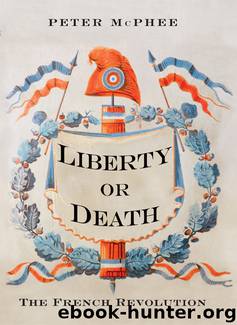Liberty or Death by Peter McPhee

Author:Peter McPhee
Language: eng
Format: epub, mobi
ISBN: 9780300189933
Publisher: Yale University Press
CHAPTER FOURTEEN
SETTLING SCORES
THE THERMIDORIAN REACTION, 1794–95
THE THERMIDORIANS WERE HARDENED MEN WHO HAD LIVED through fifteen months of fearful apprehension, and they were determined that their experience would not be repeated.1 These men, the new majority in the Convention, were former Girondins, the ‘Plain’, and the anti-Robespierrist Jacobins. Their ‘Thermidorian regime’ in place from July 1794 was certainly republican, but driven above all else by the need to end the Revolution, most obviously by suppressing the sources of instability represented by the Jacobins and sans-culottes. In seeking to end revolutionary upheaval, they unleashed ferocious reaction against those blamed for the perceived excesses of what was now called ‘the Terror’, and a counter-reaction from those seeking to protect what had been won by sacrifice and virtue in 1793–94. It was a time of retribution, despair and some optimism for a settled future (Fig. 30).
One of the first new members of the Committee of Public Safety was Jean-Lambert Tallien, among those most active in the overthrow of the Robespierrists, and under suspicion for having been too influenced in Bordeaux by his lover, the former noblewoman Thérésia Cabarrus. Tallien, when just twenty-six years old, had instigated with Claude-Alexandre Ysabeau a bloodily punitive repression of federalism in Bordeaux in August 1793, but now he appealed to the Convention one year later to dismantle all the evils of the Terror: ‘this was Robespierre’s system; he was the one who put it into practice with the help of a few subordinates.… The Convention was a victim of it, never an accomplice.’ Those who suggested that the Convention should take some responsibility were in fact guilty of sharing in the ‘monster’ Robespierre’s ‘infernal system’.2 Tallien arranged for the release of Cabarrus from prison; they married in December 1794 and Thérésia gave birth to a daughter, named Thermidor. Indeed, Thérésia herself was often called ‘Notre Dame de Thermidor’. Those closest to Robespierre, such as Rosalie Jullien, whose young son Jules had confronted Tallien in Bordeaux when an agent for the Committee of Public Safety, now had to appeal obsequiously to Cabarrus as a mother and a woman linked by ‘the natural sensitivity of our sex’ to secure Jules’ release from prison.3
Robespierre had almost immediately become the personification of the Terror across France and the subject of preposterous claims and rumours. The seamstress Jeanne-Victoire Delzigue of Orléans wrote solemnly in her diary on 2 August 1794:
the good fortune for those who had been imprisoned as suspects was that as soon as Robespierre was dead all the prisons of France were opened.… Robespierre had said before his death that my head is going to be cut off but they won’t cut off my queue (penis), which is much worse …4
Delzigue was certainly correct that the overthrow of the Robespierrists would be the signal for the release of most of the suspects in the prisons of Paris. On 14 Thermidor (1 August) the Law of 22 Prairial was repealed, and the scope of the Revolutionary Tribunal was narrowed to consider only those who had actually taken up arms against the Republic.
Download
This site does not store any files on its server. We only index and link to content provided by other sites. Please contact the content providers to delete copyright contents if any and email us, we'll remove relevant links or contents immediately.
| Belgium | France |
| Germany | Great Britain |
| Greenland | Italy |
| Netherlands | Romania |
| Scandinavia |
Room 212 by Kate Stewart(5070)
The Crown by Robert Lacey(4760)
Endurance: Shackleton's Incredible Voyage by Alfred Lansing(4716)
The Iron Duke by The Iron Duke(4319)
The Rape of Nanking by Iris Chang(4165)
Joan of Arc by Mary Gordon(4052)
Killing England by Bill O'Reilly(3968)
Say Nothing by Patrick Radden Keefe(3937)
I'll Give You the Sun by Jandy Nelson(3394)
Shadow of Night by Deborah Harkness(3324)
Hitler's Monsters by Eric Kurlander(3290)
Mary, Queen of Scots, and the Murder of Lord Darnley by Alison Weir(3171)
Blood and Sand by Alex Von Tunzelmann(3164)
Eleanor & Park by Rainbow Rowell(3109)
Darkest Hour by Anthony McCarten(3096)
Margaret Thatcher: The Autobiography by Thatcher Margaret(3046)
Book of Life by Deborah Harkness(2892)
Red Famine: Stalin's War on Ukraine by Anne Applebaum(2890)
The One Memory of Flora Banks by Emily Barr(2829)
